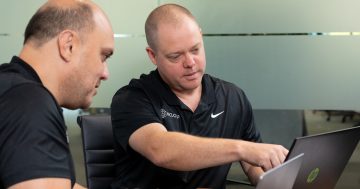Kelly Manthey* says going at 100 mph means you are reactive, rather than responsive.
 If there’s one constant among business leaders, it’s the understanding that you need to be constantly moving forward.
If there’s one constant among business leaders, it’s the understanding that you need to be constantly moving forward.
In a world where technology and consumer behaviours are changing faster than ever before, sitting still is seen as just one step away from irrelevance.
But always moving forward isn’t the same thing as always moving fast.
Sometimes, intentionally applying the brakes to assess what’s ahead or to glance over your shoulder to see what’s coming is how to chart the best path forward—leading to supercharged growth in the future.
I think about all-star wide receivers: Their feet are always headed down field, but they adjust to coverage ahead and look back to spot where the ball is going.
Their quarterback trusts them to do that, just as they trust their quarterback to know when to run a hurry up offense or call a timeout to regroup.
The idea of slowing down to speed up isn’t new, but it is an especially important consideration during a period of uncertainty.
The value of pacing yourself and occasionally taking a moment to rethink your strategy is evergreen, whether you’re a CEO or about to take the snap at third and goal.
Adopt an iterative approach
As your business progresses, there will be a wealth of potential growth drivers and strategic options: How should we scale? What should (or shouldn’t) we invest in? Where are our most important areas of innovation?
Deciding what not to do can be incredibly tricky when there are so many available possibilities and opportunities.
Excitement and ambition will inspire you to try and accomplish everything, but applying the slow-down-to-speed-up thinking will allow you to test what will work best for your business.
It comes down to focus and being clear on the choices you make.
Adopting an iterative, test-and-learn approach can also provide insight into staying the course or pivoting.
Leaders can identify the right triggers that move their business toward a change or new opportunity—therefore being thoughtful as well as agile, even if it might look like the business is temporarily slowing down.
Then you can move at pace again, but in a more controlled and sustainable way.
That’s much easier to sell to the board and stakeholders: If they understand the thinking behind the journey, they’ll understand that the business is moving toward longer-term value.
Be responsive, not reactive
Constantly going at 100 mph also means you could be perceived as a reactive leader, rather than a responsive one.
Being wholly reactive suggests a lack of discipline and that all-important focus, breeding a sense of unease in your team and a scaling up strategy that never quite scales.
Instead, set a more sustainable and competitive pace where your team doesn’t feel overstretched or frantic.
And, as the leader of this pace group, be highly conscious of what’s a distraction to be avoided and what is important enough to respond to that you should alter your speed or change course entirely.
Preview the destination
Can you imagine getting in the driver’s seat of your car and someone says, “Don’t worry, just follow the directions on the GPS”?
You don’t know where you’re going, you don’t know the steps to get there, you can’t apply your experience to avoid high traffic areas, and you can never enjoy the ride because you don’t know what’s coming next.
It sounds terrible, doesn’t it?
This is how your teams will feel unless you preview the destination with them.
Take the time to paint the bigger picture of where you’re headed as a group and then focus on the next steps rather than just charging forward.
This not only creates clarity of roles and alignment within the business, but it also gives your leadership team a chance to apply their expertise to help make even better decisions to get where you’re going faster.
They each have areas of responsibility and it’s vital they are all aligned so they move at the same pace.
This level of transparency should be afforded to all of your employees, as well.
If they can see the destination, understand the plan to get there, and are aware of the thought and care that went into that plan, they will be more confident to move quickly in the right direction.
Choose and move
So, you’ve applied test and learn, you’ve spotted distractions and avoided them, and you’ve painted the bigger picture for your organization—now it’s time to move!
The worst thing that can happen is analysis paralysis.
Have confidence in your choices and push forward.
Your teams will feed off of that confidence and momentum and it will have a trickle-down effect on the whole company.
Don’t worry if you stumble.
Slow down, take stock of where you are, remember the destination, and go get it.
*Kelly Manthey is the global CEO at digital transformation consultancy Kin + Carta.
This article first appeared at fastcompany.com










